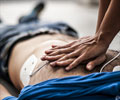Public access defibrillation (PAD) programs are unevenly deployed across France, with an obvious impact on out-of-hospital cardiac arrest (OHCA) survival rate.

‘Public access defibrillation (PAD) programs are unevenly deployed across France, with an obvious impact on out-of-hospital cardiac arrest (OHCA) survival rate.’





"The survival rate of OHCA remains extremely low," said Dr Nicole Karam, an interventional cardiologist at the European Hospital Georges Pompidou in Paris, France, on behalf of the Paris Sudden Death Expertise Centre led by Professor Xavier Jouven. "The importance of the early minutes of OHCA management is well recognised and PAD programmes have been developed to increase both AED availability and basic life support awareness," she continued. "However, no study has assessed the deployment of these programmes in real life."
The current study, coordinated by Dr Eloi Marijon, was a five-year national prospective assessment of PAD programmes conducted throughout 51 districts in France. The two arms of PAD programmes were evaluated: density of deployed AEDs (per 100 000 inhabitants/1000 km2) and proportion of persons educated in basic life support at least once during the five year period (per 100 000 inhabitants), either by public governmental or private initiatives.
The researchers found huge discrepancies in PAD development across the districts. The proportion of educated persons varied from 6955 to 36 636 per 100 000 inhabitants, while the density of AEDs varied from five to 3399 per 100 000 inhabitants/1000 km2. Overall, only 35.3% of districts developed a significant programme, defined by the authors as both AED density and educational rate above the median (more than 22 AEDs per 100 000 inhabitants/1000 km2 and more than 13 866 educated persons per 100 000 inhabitants).
"These discrepancies were way beyond those we expected," said Dr Karam. "Around a third of districts developed complete PAD programmes, while others either did not invest sufficiently in any of the two arms (37.2%), or only focused on one of the two components. There was no correlation between the implementation rates of the two components, as if there was no global strategy to effectively deploy complete PAD programmes."
Advertisement
Survival rate was much more correlated to the number of educated individuals (correlation coefficient 0.89) than to the number of available AEDs (0.25). In multivariate analysis, only the level of population education was independently associated with survival (odds ratio 1.64, P = 0.004).
Advertisement
Source-Eurekalert









